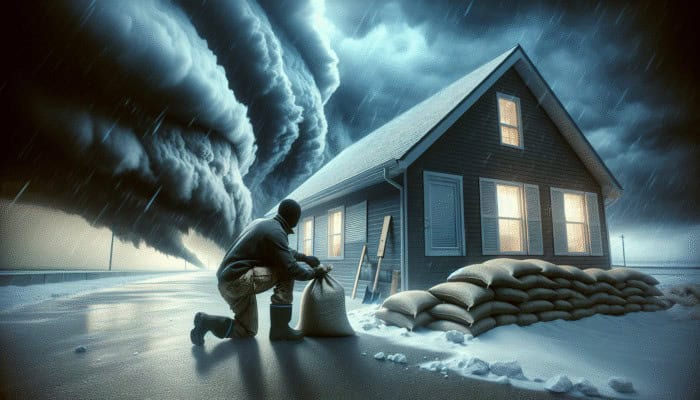Comprehending the Impact and Dynamics of Hailstorms
Surviving a Hailstorm: Hailstorms are a captivating yet hazardous type of weather event that can inflict substantial damage within minutes. Gaining a thorough understanding of the complex processes involved in hail formation, forecasting, and crucial patterns is essential for anyone keen on ensuring safety during a hailstorm. These storms are not confined to particular areas; they can occur in various locations worldwide, leaving behind a path of devastation that knows no geographical boundaries.
Discovering the Mechanisms Behind Hail Formation

The formation of hail is a multifaceted process initiated by powerful thunderstorms. As a storm develops, intense updrafts propel water droplets high into the frigid regions of the atmosphere. In these altitudes, temperatures drop sharply, causing the droplets to freeze upon meeting ice nuclei—tiny particles that act as the foundation for ice creation. This process continues as the updraft carries the frozen droplets upward, allowing them to grow by colliding with supercooled water, which remains liquid at freezing temperatures. This cycle can endure, enabling the hailstone to accumulate multiple layers of ice until it becomes too heavy for the updraft to support, ultimately resulting in its descent to the ground.
Hailstones can vary greatly in size, ranging from small pellets to larger stones that can rival the dimensions of golf balls or even baseballs during particularly severe storms. Regions that are frequently affected by these phenomena, such as the Great Plains of North America, experience a higher frequency of hailstorms due to conducive atmospheric conditions, where warm, moist air collides with cooler air masses. Gaining an understanding of these dynamics not only sheds light on how hail forms but also empowers individuals with the knowledge to predict its arrival and take appropriate precautions.
Enhancing Your Ability to Anticipate Hailstorms
The capacity to predict hailstorms has seen substantial improvements in recent years, primarily due to advancements in meteorological technology. Meteorologists employ sophisticated radar systems to identify storms that display characteristics typically associated with hail production, such as robust updrafts and distinctive reflectivity signatures. Nevertheless, accurately predicting the precise timing and location of hail can remain a formidable challenge, particularly given the abrupt nature of weather patterns.
To bolster personal safety during potential hailstorms, staying informed is crucial. Utilising weather apps and alert systems can provide real-time updates, significantly enhancing individuals’ chances of surviving a hailstorm. These digital tools not only alert users to impending storms but also provide information on the storm’s intensity, facilitating timely precautionary measures. Engaging with local weather forecasts can further enhance personal preparedness, transforming what could be a catastrophic event into a manageable situation.
Understanding the Frequency of Hailstorm Occurrences
Hailstorms are not restricted to a specific season; they can occur throughout the year, although certain regions experience a marked increase in frequency during particular months. For example, the United States witnesses a surge in hail activity during the spring and early summer months, as warm air masses collide with creating fronts, generating the ideal conditions for thunderstorms. However, other parts of the globe, including Southeast Australia and certain regions of Europe, can also face hailstorms, albeit with distinct seasonal variations.
Recognising local weather patterns is imperative for anyone seeking to reduce risks associated with hail. By understanding when and where hail is most likely to occur, individuals can implement proactive strategies to safeguard their property and well-being, thereby enhancing their overall resilience in the face of unpredictable weather phenomena.
Strategies for Effective Hailstorm Preparedness

Preparation is fundamental for effectively navigating the tumultuous weather conditions associated with hailstorms. By taking proactive measures, individuals can substantially improve their chances of surviving a hailstorm while minimizing damage and injury.
Implementing Home Protection Strategies
Securing your home against hail damage begins with identifying vulnerable areas that could be easily compromised. Items such as garden furniture, decorative pieces, and even bicycle stands should be brought indoors or secured to prevent them from becoming hazardous projectiles in high winds. Reinforcing windows and skylights is another vital step; installing storm shutters or using plywood can offer additional protection against breaking glass, which poses a significant risk of injury during a hailstorm. Furthermore, investing in hail-resistant roofing materials, such as metal or impact-resistant shingles, can provide greater resilience against the impact of larger hailstones compared to traditional roofing options.
A well-prepared home should also include a designated safe area, like a basement or an interior room, where family members can gather during a hailstorm. Maintaining a well-organized and easily accessible emergency kit stocked with essential supplies, including water, non-perishable food, and first aid items, can prove invaluable during extreme weather conditions. Preparing your home for potential hailstorms can significantly reduce the risk of severe damage and enhance the safety of all residents.
Ensuring Vehicle Safety During Hailstorms
Vehicles often rank among the most vulnerable assets during hailstorms. A sudden severe weather event results in damaged cars, leading to costly repairs. The most effective method for protecting vehicles is to park them in a garage or under a secure shelter, such as a carport. However, if these options are unavailable, utilising protective hail covers can be a lifesaver. These covers, typically constructed from thick, padded materials, are specifically designed to absorb the impact of hailstones, ensuring that your vehicle remains intact and free from damage.
Additionally, staying vigilant by monitoring weather alerts on mobile devices can serve as a timely reminder to relocate vehicles to safer locations before storms approach. Being proactive about vehicle safety can help mitigate the financial burden and accompanying stress associated with repairing hail-damaged cars, making it an essential aspect of preparing for hail events.
Acquiring Personal Safety Gear for Hailstorms

Personal safety during a hailstorm should never be underestimated. Keeping helmets, sturdy footwear, and protective clothing readily available can be critical if you need to move during a storm. Hail can cause serious injuries, and being adequately equipped can prevent unnecessary harm. Helmets designed for sports or construction work can provide essential protection for your head against falling objects, such as hailstones.
Equally important is having strong, durable footwear, as hail can scatter debris that might cause cuts or tripping hazards. Opt for shoes with thick soles and ankle support to protect against sharp objects. Furthermore, wearing layers of protective clothing can also help shield the skin from both hail and falling debris. The significance of personal safety gear cannot be overstated; having these items readily accessible can mean the difference between a close call and a serious injury during a hailstorm.
Establishing a Comprehensive Emergency Preparedness Plan
Developing an effective emergency preparedness plan is a proactive strategy for ensuring safety during hailstorms. This plan should encompass identifying the safest areas in your home and ensuring that all family members are aware of these locations. Conducting practice drills can be invaluable, as they help prepare everyone for the chaos that often accompanies A crucial event.
An essential component of the plan is having an emergency kit readily available for use. This kit should include basic supplies such as water, non-perishable food items, first aid materials, and flashlights. Beyond physical supplies, maintaining open communication channels is vital. Ensure that everyone in the household knows how to access local weather updates and alerts via mobile apps or local news outlets. By being informed and prepared, individuals can navigate hailstorms with confidence, significantly enhancing their chances of surviving a hailstorm with minimal impact.
Actions to Take During a Hailstorm
When a hailstorm approaches, immediate and decisive action is vital for ensuring safety and minimising damage. Knowing how to respond during these intense weather events can significantly increase the likelihood of successfully navigating the storm.
Staying Indoors for Maximum Safety
The safest location during a hailstorm is indoors, away from windows and doors. High winds and hail have the potential to shatter glass, resulting in serious injuries. Seeking shelter in a basement or an interior room devoid of windows is the optimal strategy for ensuring safety. It is crucial to remain calm and avoid panicking during the storm. Gather family members in a safe area and stay updated on weather conditions via mobile devices or battery-operated radios.
If you have pets, ensure they are also secured in a safe area away from windows. Establishing a calm environment can help alleviate anxiety for both humans and animals during the storm. Additionally, if you have young children, engaging them in fun activities can distract them from the storm, making the experience less frightening.
Actions to Take if Caught Outdoors
For those caught outdoors during a hailstorm, seeking immediate shelter is critical. If a sturdy structure, such as a building or a large gazebo, is available, make your way there as quickly as possible. Vehicles can also provide temporary refuge, but avoid parking under trees, as branches can break and pose additional hazards. Open fields should be avoided at all costs, as they expose you to the full force of the storm, including lightning, which often accompanies hail.
If no shelter is available, crouching down in a ball and covering your head with your arms can provide some protection against hailstones. It is crucial to remain as low to the ground as possible to minimise exposure. Staying informed about the storm’s path through weather apps or emergency alerts can help you manage the situation more effectively.
Strategies for Protecting Livestock During Hailstorms
For farmers and ranchers, safeguarding livestock during a hailstorm presents unique challenges. If time allows, animals should be moved to sheltered areas, such as barns or enclosed pens. Providing bedding and clean water in these shelters will help keep livestock comfortable and reduce stress during the storm.
If relocation of livestock is not feasible, consider covering enclosures with hail-resistant materials to minimise injury damage. Creating a haven for animals not only protects them but also ensures the continued operation of agricultural businesses after the storm passes. Understanding the unique requirements of various types of stock can inform better preparation and enable more effective strategies for recovery after a storm.
Protecting VehPrioritizingail Damage
Prioritising the protection of vehicles during a hailstorm is as important as ensuring one’s own and personal safety. Whenever possible, always park cars in a garage or under a carport to shield them from hail. In the absence of these options, investing in hail-resistant car covers or utilising thick blankets can offer substantial protection against hail damage.
Additionally, consider using vehicle floor mats or cushions to pad vulnerable areas. Keeping an emergency kit in the car could also prove beneficial, containing water, first aid supplies, and a flashlight for unanticipated situations arising from hail-related incidents. The objective is to minimise damage to your vehicle, ensuring it remains functional and intact after the storm has passed.
Steps for Recovery After a Hailstorm
The aftermath of a hailstorm can be overwhelming, with damage assessment, cleanup, and recovery efforts requiring immediate attention. Knowing how to navigate this phase effectively can lead to a smoother recovery process.
Conducting a Thorough Damage Assessment
Once the hailstorm has subsided, assessing the damage is the initial step towards recovery. Begin by inspecting your property for damage to roofs, windows, and vehicles. Look for signs of impact, such as dents in metal surfaces or broken glass. Documenting the damage through photographs is crucial for insurance claims, as it provides essential evidence of the storm’s impact.
When examining your home, pay close attention to areas where hail can penetrate, such as skylights, gutters, and eaves. For vehicles, inspect not only the exterior but also any glass components for cracks or breaks. A comprehensive assessment can help you identify necessary repairs and guide you through the insurance claims process effectively.
Effective Cleanup Strategies
Cleaning up after a hailstorm is crucial for preventing additional damage to your property. Start by removing debris and any fallen branches from your yard. Utilise protective gear, such as gloves and sturdy footwear, to avoid injury from sharp objects or broken glass. If the storm caused substantial damage, consider consulting professionals for debris removal and repairs.
Be vigilant about checking for leaks in roofs or windows, as these can lead to water damage if not addressed quickly. Clearing gutters and downspouts of hail and debris will also help prevent water accumulation and subsequent issues. A proactive approach to cleanup will facilitate a quicker recovery and restore your property to its pre-storm condition.
Filing Insurance Claims Effectively
Contact your insurance provider as soon as possible to initiate the claims process. Providing comprehensive documentation of the damage, including photographs and repair estimates, can expedite your claim and ensure you receive the necessary funds for repairs. Understanding your policy is crucial; some policies may cover specific types of damage while excluding others.
Keep meticulous records of all communications with your insurance company and contractors. If you encounter difficulties or delays, do not hesitate to escalate your claim. Persistence can often yield favourable results. By being proactive and organised, you can navigate the insurance process more efficiently, alleviating stress during the recovery phase.
Implementing Long-Term Prevention Strategies
The aftermath of a hailstorm presents an opportunity to reevaluate and strengthen your long-term strategies aimed at minimising future risks. By implementing preventive measures, you can enhance your resilience against future storms.
Reinforcing Your Structures Against Hail
Investing in hail-resistant materials for roofs, windows, and siding can drastically reduce the potential damage from hailstorms. Choosing materials specifically designed to withstand severe weather conditions, such as impact-resistant shingles or reinforced glass, can not only protect your property but may also lead to lower insurance premiums over time.
In addition, retrofitting existing structures with protective features such as storm shutters or reinforced window frames can significantly bolster your property’s defences. Consulting with contractors experienced in weather-resistant construction can guide you in making informed decisions regarding upgrades and renovations to enhance your home’s resilience.
Implementing Strategic Landscaping to Mitigate Hail Damage
Strategically designed landscaping can serve as a natural barrier against hail damage while simultaneously enhancing the aesthetic appeal of your property. Planting trees and shrubs in specific configurations can deflect hail and provide shade, thereby reducing the likelihood of direct damage to structures and vehicles.
Choose hardy plant species that can withstand hail without suffering significant damage. Additionally, maintaining healthy trees through regular pruning and care can prevent branches from breaking during storms. A thoughtfully landscaped property not only offers additional protection from hail but also contributes to a more sustainable environment overall.
Preparing Well-Stocked Emergency Kits for Future Storms
Maintaining a well-stocked emergency kit is crucial for long-term preparedness against hailstorms. This kit should include essentials such as flashlights, batteries, first aid supplies, and protective gear. Regularly check and replenish supplies to ensure everything is functional and up to date.
Consider customising your emergency kit based on specific needs, such as including medications or specialised equipment for family members with health conditions. By preparing ahead of time, you can ensure a swift response during adverse weather conditions, significantly improving your chances of surviving a hailstorm and its aftermath.
Prioritising Regular Maintenance for Your Property
Scheduling regular inspections and maintenance of your property can help identify vulnerabilities that could exacerbate hail damage. Routine checks on roofs, gutters, and windows allow homeowners to address issues before they escalate into more significant problems.
Engaging professional services for inspections and repairs ensures that your property remains in optimal condition. Timely repairs not only bolster your defences against hail but also contribute to the overall longevity and value of your home. A proactive maintenance routine ensures that you are always prepared, regardless of what unpredictable weather events may arise.
Fostering Community Preparedness for Hailstorms
Engaging with your community to develop a collective response plan for hailstorms can enhance overall resilience and facilitate quicker recovery. Collaborating with neighbours to share resources, information, and preparedness strategies can create a supportive network during severe weather events.
Consider organising community meetings or workshops to discuss hail safety measures and response strategies. By cultivating a culture of preparedness, communities can collectively build resilience against hailstorms, ensuring that everyone is better equipped to handle the challenges they present.
Empowering Your Community Through Education
Education serves as a vital component in preparing for the unpredictable nature of hailstorms. By disseminating knowledge and resources, communities can enhance their overall preparedness and resilience in the face of such weather events.
Hosting Workshops and Seminars on Hailstorm Preparedness
Organising educational workshops and seminars can be an effective means of sharing knowledge about hailstorm preparedness. Invite local meteorologists or emergency management officials to discuss the importance of understanding hailstorms and effective strategies for responding to these events.
These events can cover topics such as home protection measures, vehicle safety, and personal safety gear. Providing participants with actionable steps and resources can empower them to take control of their safety and preparedness. Engaging community members through interactive activities, such as drills or simulations, can further reinforce learning and retention.
Implementing Community Outreach Programs for Hail Safety
Implementing an outreach program helps educate and inform about hailstorm safety measures and response strategies. Collaborate with local organisations to distribute materials, such as pamphlets or flyers, detailing essential information about hail preparedness.
Outreach initiatives could also include door-to-door campaigns, reaching vulnerable populations who may require additional assistance. Utilising social media platforms can amplify the message, spreading awareness about hailstorm preparedness to a broader audience. By fostering community engagement, outreach programmes can cultivate a culture of safety and preparedness.
Integrating School and Youth Education on Hail Safety
Launching educational initiatives in schools can play a pivotal role in teaching children about hailstorm preparedness and safety. Incorporating lessons about severe weather, including hail, into the curriculum can equip younger generations with the knowledge they need to respond effectively to such events.
Consider organising school-based drills to familiarise students with emergency protocols in the event of a hailstorm. Partnering with local meteorological organisations can provide valuable resources and expertise. By investing in youth education, communities can cultivate a well-informed population prepared to confront future weather challenges head-on.
Frequently Asked Questions About Hailstorms
What precautions should I take before a hailstorm strikes?
Before a hailstorm, secure outdoor items, reinforce windows, and consider installing hail-resistant roofing. Keep an eye on weather updates through apps and alerts to stay informed.
What are effective ways to protect my car from hail damage?
Park your car in a garage or carport; if these are not options, utilise hail-resistant covers or thick blankets to shield it from potential hail impacts.
Is there a particular time of year when hailstorms are more prevalent?
Hailstorms can occur throughout the year, but they tend to be more frequent in spring and early summer in many regions, particularly in the Great Plains.
What actions should I take if I find myself outdoors during a hailstorm?
Seek immediate shelter under a sturdy structure or vehicle; avoid trees and open fields to protect yourself from both hail and lightning hazards.
How can I effectively assess damage after a hailstorm?
Inspect your property for damage to roofs, windows, and vehicles. Document the damage with photographs, which will help process insurance claims.
What should I include in my emergency kit?
Your emergency kit should comprise essentials such as water, non-perishable food, first aid supplies, flashlights, and protective gear to ensure readiness during emergencies.
How can I reinforce my home against future hailstorms?
Consider upgrading to hail-resistant materials for your roof to protect your home from hail damage to windows and siding. Regular maintenance helps identify and address vulnerabilities.
What landscaping strategies are effective in protecting my property from hail?
Planting trees and shrubs in strategic locations can act as natural barriers against hail. Choose resilient species that can withstand hail without sustaining significant damage.
How can I contribute to educating my community about preparing for hailstorms?
Organise workshops, outreach programmes, or school initiatives to disseminate knowledge regarding hailstorm safety measures and response strategies.
What proactive steps can I take for long-term hailstorm preparedness?
Engage in regular property maintenance, devise emergency plans, and participate in community preparedness efforts to enhance overall resilience against hailstorms.
Explore our world on X!
Post-Disaster Bartering: Essential Strategies
Exploring the Concept of Post-Disaster Bartering What Is the Concept of Post-Disaster Bartering? Post-Disaster Bartering: Post-disaster bartering refers to the exchange of goods and services that occurs when conventional currency systems collapse due to catastrophic events, such as natural disasters, economic crises, or societal upheavals. During these critical moments, individuals and communities utilise the resources […]
Hurricane Generator Use: Powering Through Storms
Maximising the Benefits of Hurricane Generator Usage What Exactly Are Hurricane Generators? Hurricane Generator Use: Hurricane generators are advanced power supply devices specifically engineered to deliver electricity during extreme weather events, particularly during hurricanes, when standard power infrastructures may fail. These robust machines ensure that both residential and commercial establishments receive the power they need, […]
Emergency Family Plan: Universal Preparation Guide
Comprehensive Elements to Include in Your Family Emergency Plan Effective Communication Strategies for Emergencies Emergency Family Plan: Establishing effective communication strategies is absolutely vital for ensuring that family members remain connected and informed during emergencies. It’s crucial to have clear, reliable methods in place that everyone understands and can utilise effortlessly. This encompasses traditional communication […]
Survival Water Bottles: Essential Gear for Emergencies
Why Survival Water Bottles are Essential for Emergency Preparedness Understanding the Significance of Hydration in Crisis Situations Survival Water Bottles: Maintaining hydration is vital for ensuring optimal bodily functions during emergencies. In scenarios where access to clean water is limited, sustaining proper hydration is crucial in preventing health complications associated with dehydration, which can include […]








This discussion on hailstorms really resonates with me, especially considering the recent discussions around severe weather patterns becoming more unpredictable due to climate change. Your explanation of hail formation is fascinating, and it’s incredible to think about the sheer power of nature that can create such damaging phenomena in just a few minutes.
Your insights into the dynamics of hailstorms really resonate with me, especially the emphasis on their unpredictable nature and the critical importance of understanding hail formation. Having experienced a few extreme weather events myself, I can attest to how quickly conditions can shift and the profound impact it can have on communities, both economically and emotionally.
Your exploration of hailstorms is both enlightening and timely, especially considering the increasing unpredictability of weather patterns due to climate change. As you mentioned, understanding the mechanics behind hail formation is crucial not just for meteorologists, but also for everyday people who may find themselves caught in such severe weather.